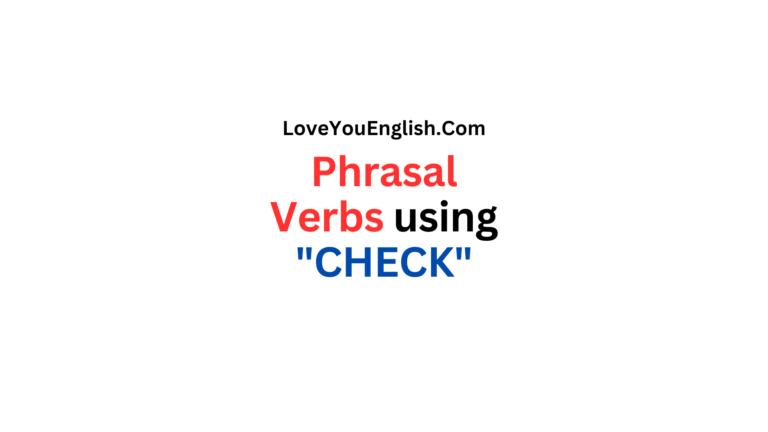Phrasal Verbs and Their Usage: A Guide About Phrasal Verbs
Sharing is caring!
Have you ever wondered why native English speakers often say “give up” instead of just “quit” or “look after” instead of “care for”? These are phrasal verbs, and they are an important part of everyday English.
Phrasal verbs can make your conversations sound more natural, but they can also be tricky to learn because their meanings often change depending on the words used together.
In this post, I’ll tell you what phrasal verbs are, how they work, and how you can use them confidently in your daily conversations.
What Are Phrasal Verbs?
A phrasal verb is a combination of a verb and one or more particles (prepositions or adverbs). Together, they create a new meaning different from the individual words.
For example:
- Look after (verb + preposition) means to take care of someone or something.
She looks after her younger brother. - Give up (verb + adverb) means to stop doing something.
He gave up smoking last year.
Types of Phrasal Verbs
Phrasal verbs can be classified into four main types based on their structure and whether they need an object:
1. Transitive Phrasal Verbs (need an object)
These phrasal verbs must have a direct object.
- Bring up – to raise a topic or a child
She brought up an interesting point during the meeting. - Turn off – to switch off or stop something
Can you turn off the lights, please?
2. Intransitive Phrasal Verbs (do not need an object)
These phrasal verbs make sense without an object.
- Wake up – to stop sleeping
I wake up at 6 a.m. every day. - Break down – to stop working (for machines)
My car broke down on the way to work.
3. Separable Phrasal Verbs
With these phrasal verbs, the object can come between the verb and the particle.
- Put off – to postpone
They put off the meeting until next week.
They put the meeting off until next week.
4. Inseparable Phrasal Verbs
The object must come after the entire phrasal verb.
- Look after – to take care of
Can you look after my dog while I’m away? - Get over – to recover from
It took her months to get over the breakup.
Common Phrasal Verbs and Their Meanings
Here are some frequently used phrasal verbs that you can start using in your conversations:
Phrasal Verbs with “Get”
- Get up – to rise from bed
I get up early on weekdays. - Get along with – to have a good relationship
I get along well with my classmates. - Get over – to recover from something
She finally got over her cold.
Phrasal Verbs with “Take”
- Take off – to remove (clothing) or to depart (airplane)
The plane took off on time. - Take after – to resemble a family member
She takes after her mother. - Take up – to start a new hobby or activity
He has taken up painting recently.
Phrasal Verbs with “Look”
- Look after – to take care of
She looks after her grandmother. - Look forward to – to be excited about something in the future
I’m looking forward to my vacation. - Look into – to investigate
The police are looking into the incident.
Phrasal Verbs with “Make”
- Make up – to invent or to reconcile
She made up an excuse for being late.
They made up after their argument. - Make out – to understand or to see clearly
I couldn’t make out what he was saying. - Make up for – to compensate for
She worked hard to make up for her mistakes.
Why Are Phrasal Verbs Important?
- Improve Fluency: Native speakers use phrasal verbs frequently in conversations. Learning them will help you understand and speak more naturally.
- Add Variety: Phrasal verbs make your language richer and more colorful. Instead of always using simple verbs, you can use expressions that sound more native.
- Master Informal English: Phrasal verbs are common in everyday, informal conversations.
How to Learn and Remember Phrasal Verbs
1. Group Them by Verb
Learn phrasal verbs with the same base verb. For example:
- With “Get”: get up, get over, get along with
- With “Look”: look after, look forward to, look into
2. Learn by Context
Read stories, watch movies, and listen to conversations where phrasal verbs are used. This will help you understand their meaning naturally.
3. Practice with Flashcards
Make flashcards with the phrasal verb on one side and the meaning with an example on the other.
4. Use Them in Sentences
Create your own sentences using new phrasal verbs. This will help you remember them better.
5. Play Word Games
Crossword puzzles, quizzes, and matching games can make learning phrasal verbs fun.
Phrasal Verbs in Daily Conversations (Examples)
- At the Office:
- Can you look into this issue?
- Let’s put off the meeting until tomorrow.
- At Home:
- Can you turn off the TV?
- She took up gardening last month.
- With Friends:
- I can’t make out what he’s saying.
- Let’s hang out this weekend.
Common Mistakes with Phrasal Verbs (And How to Avoid Them)
- Using the wrong particle:
Look over the baby.
Look after the baby. (to take care of)
- Wrong word order with separable phrasal verbs:
Turn the lights off them.
Turn off the lights.
- Confusing meanings:
Phrasal Verbs Quiz (Test Your Knowledge)
Try to complete these sentences with the correct phrasal verb:
- I always _______ my keys in the morning. (look for/look into)
- She _______ smoking last year. (gave up/gave in)
- Can you _______ the music? It’s too loud. (turn off/turn up)
- He quickly _______ from his cold. (got over/got off)
- We _______ our trip because of the rain. (put off/put out)
(Answers: 1. look for 2. gave up 3. turn down 4. got over 5. put off)
Conclusion
Phrasal verbs are essential for mastering English conversations. They may seem confusing at first, but with regular practice, you will become comfortable using them. Start by learning a few every day and using them in your conversations. Over time, they will become a natural part of your English speaking.
So, are you ready to take on the challenge of learning more phrasal verbs? Start today, and you’ll soon see your English skills improve!
Read more:
- 25 Essential Résumé Writing Tips
- Interview Tips: How to Get the Job
- The Dos and Don’ts of Remote Work Etiquette
- STAR Interview Questions and Answers
- 25 Clothing Idioms and What They Mean
Resources:
Sharing is caring!







